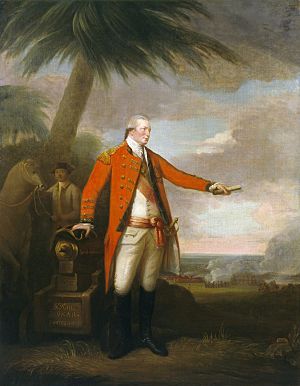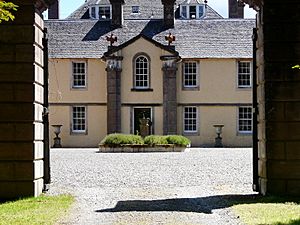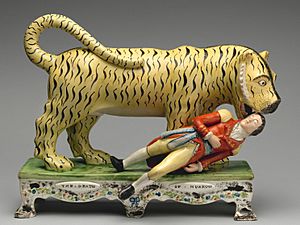Hector Munro, 8th Laird of Novar facts for kids
Quick facts for kids
Hector Munro
|
|
|---|---|
 |
|
| Member of Parliament for Inverness Burghs | |
| In office 1801–1802 |
|
| Preceded by | Himself, as a member of the Parliament of Great Britain |
| Succeeded by | Alexander Cumming-Gordon |
| In office 1768–1801 |
|
| Preceded by | Sir Alexander Grant |
| Succeeded by | Himself, as a member of the Parliament of the United Kingdom |
| Personal details | |
| Born | 1726 Ross, Scotland |
| Died | 27 December 1805 (aged 78–79) Scotland |
| Awards | Knight Companion of the Order of the Bath |
| Military service | |
| Allegiance | |
| Branch/service | |
| Years of service | 1747–1782 |
| Rank | General |
| Unit | Loudon's Highlanders, 31st Foot, 34th Foot, 48th Foot, 70th Foot, 89th Foot |
| Commands | Commander-in-Chief of Bengal |
| Battles/wars | Jacobite rising of 1745 Battle of Buxar Second Anglo-Mysore War |
General Sir Hector Munro (1726 – 27 December 1805) was a brave Scottish army officer and politician. He was known as the 8th Laird of Novar. He served as the Commander-in-Chief of Bengal in India from 1764 to 1765. Sir Hector Munro had a long and important career, both in the military and in politics.
Contents
Early Life and Military Beginnings
Hector Munro was born in Ross, Scotland, in 1726. His family owned Novar House, a large estate. They also had a home in Golspie, Sutherland.
He joined the local militia, a group of citizen soldiers. This group fought for the government during the Jacobite rising of 1745. This was a time when some people in Scotland wanted to bring back the old royal family. Hector's militia helped defeat the Jacobites at the Battle of Littleferry in 1746.
Soon after, he joined the regular army. He likely started in the 64th (Loudon's Highlanders) Regiment in 1747. A story says he got his first officer job after helping the Duchess of Gordon. He safely drove her coach when her driver was unable to. The Duchess then used her influence to get him a Lieutenant's position.
Facing Rebels in Scotland
In the 1750s, Hector Munro was given a special task. He had to find and arrest rebels in Scotland. These were people who had supported the Jacobite cause.
One famous rebel he captured was John Du Cameron, also known as "Sergent Mòr." Cameron was later executed in Perth. Munro also tried to capture Ewen MacPherson of Cluny, another Jacobite. Macpherson managed to escape to France. There's a story that Macpherson once pretended to be a stable worker. He held Munro's horse while Munro searched his house for him! Munro supposedly gave him a shilling for his help.
In 1759, Hector Munro became a major in the new 89th (Highland) Regiment of Foot.
Adventures in India
In December 1760, Munro's regiment sailed to India. They arrived in Bombay in November 1761. India was a very important place for the East India Company. This company was a powerful British trading organization.
A part of the 89th regiment joined an army near Patna. Major Hector Munro took command of this army. He faced a serious challenge: a large mutiny among his soldiers, called Sepoys. A mutiny is when soldiers refuse to obey orders. Munro acted very strictly to restore discipline.
After bringing order back, he led his troops into battle. On 23 October 1764, they fought the Battle of Buxar. Munro's army was much smaller than the enemy's. But he led his men to a great victory. The enemy lost many soldiers and cannons. Munro's troops also suffered losses, but they won the battle.
This victory was very important for the East India Company. Munro received a special letter of thanks. He was also promoted to lieutenant colonel.
Serving as a Politician
After his time in India, Sir Hector Munro returned to Scotland. In 1768, he was elected as a Member of Parliament (MP). An MP is a person elected to represent an area in the British Parliament. He represented the Inverness Burghs. He continued to be an MP for over thirty years, even when he was back in India.
More Battles in India
In 1778, Munro returned to India. He took command of the East India Company's Madras Army. He captured Pondichéry from the French that year.
However, in 1780, during the Second Anglo-Mysore War, a British force was defeated. This forced Munro to retreat. Later, another general, Sir Eyre Coote, took command. In 1781, they won a big victory against Hyder Ali at Porto Novo. Munro commanded a part of the army in this battle. He also captured Negapatam in November of the same year. In 1782, he finally retired and went back to Scotland.
Back in Scotland, Sir Hector Munro ordered the building of the Fyrish Monument in 1782. He did this to give jobs to people in the area who needed work.
Later Life and Legacy
Sir Hector Munro became a full General in 1798. He retired from the army that year. He never married. He passed away on 27 December 1805 at Novar House.
He had four children. One of his sons, Hector Sutherland Munro, joined the East India Company's army. Sadly, he died in 1792 after being attacked by a tiger on Saugor Island in India. This event became very famous and was even shown in popular figures called "Staffordshire figures." Another son, Alexander Munro, died in India in 1804. His daughter, Jane Munro, married Sir Ronald Crawford Ferguson. Her descendants later inherited the Novar estate.
Sir Hector Munro was a significant figure in British military history. He played a key role in expanding British influence in India and served his country for many years.
Images for kids




